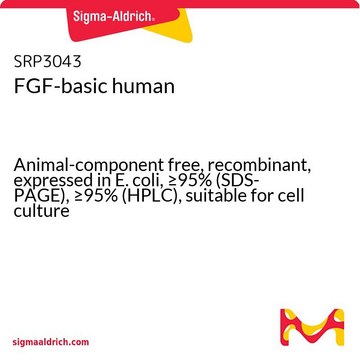Wichtige Dokumente
F3685
Fibroblast Growth Factor-Basic, human
≥97% (SDS-PAGE), recombinant, expressed in E. coli, carrier free, suitable for cell culture
Synonym(e):
FGB-b, FGF-2, HBGF-2, HBGH-2, Prostatropin, bFGF
About This Item
Empfohlene Produkte
Produktbezeichnung
Fibroblast Growth Factor-Basic, FGF-Basic, from human, recombinant, expressed in E. coli, carrier free
Biologische Quelle
human
Qualitätsniveau
Rekombinant
expressed in E. coli
Assay
≥97% (SDS-PAGE)
Form
lyophilized powder
Wirksamkeit
<1 ng/mL Biological Activity EC50
Mol-Gew.
16.0 kDa
Verpackung
pkg of 4X25 μg
pkg of 25 μg
Lagerbedingungen
avoid repeated freeze/thaw cycles
Farbe
white to faint yellow cast
Löslichkeit
water: soluble 0.025 mg, clear, colorless to faintly yellow
UniProt-Hinterlegungsnummer
Lagertemp.
−20°C
Angaben zum Gen
human ... FGF2(2247)
Allgemeine Beschreibung
Lagerklassenschlüssel
10 - Combustible liquids
WGK
WGK 1
Flammpunkt (°F)
Not applicable
Flammpunkt (°C)
Not applicable
Hier finden Sie alle aktuellen Versionen:
Besitzen Sie dieses Produkt bereits?
In der Dokumentenbibliothek finden Sie die Dokumentation zu den Produkten, die Sie kürzlich erworben haben.
Kunden haben sich ebenfalls angesehen
Unser Team von Wissenschaftlern verfügt über Erfahrung in allen Forschungsbereichen einschließlich Life Science, Materialwissenschaften, chemischer Synthese, Chromatographie, Analytik und vielen mehr..
Setzen Sie sich mit dem technischen Dienst in Verbindung.











